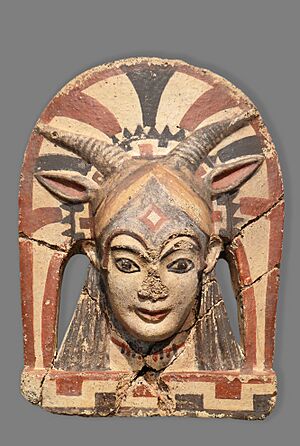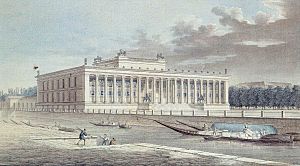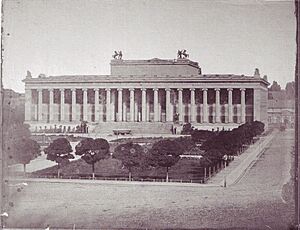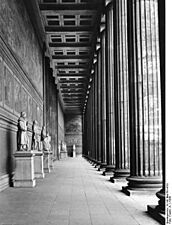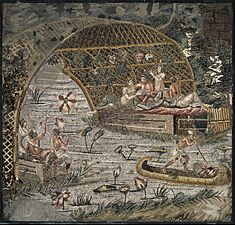Altes Museum facts for kids
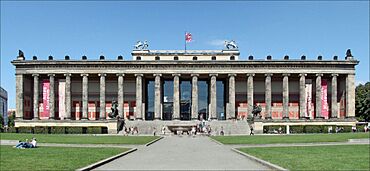
View of the Altes Museum from the Lustgarten
|
|
| Location | Museum Island, Berlin |
|---|---|
| Public transit access | U: Museumsinsel (Template:BLNMT-icon) |
The Altes Museum (which means Old Museum in English) is a very important building located on Museum Island in the heart of Berlin, Germany. It was built between 1825 and 1830. King Frederick William III of Prussia asked Karl Friedrich Schinkel to design it. Many people think it's a masterpiece of Neoclassical architecture, a style inspired by ancient Greek and Roman buildings.
The museum is surrounded by other famous landmarks. To the east, you'll find the Berlin Cathedral. To the south is the Berlin Palace, and to the west is the Zeughaus (an old arsenal). Today, the Altes Museum is home to the Antiquities Collection and some parts of the Münzkabinett (Coin Cabinet). Because it's part of the amazing Museum Island, the Altes Museum became a UNESCO World Heritage Site in 1999. This honor recognized its role in showing how museums grew to be important places for society and architecture.
Contents
History of the Altes Museum
Why the Museum Was Built
In the early 1800s, many people in Germany, especially the middle class, started to believe that art should be for everyone. They thought that all citizens should have the chance to learn about culture. King Frederick William III of Prussia strongly supported this idea. He believed in a broad education for all. So, he asked Karl Friedrich Schinkel to design a public museum for the royal art collection.
Schinkel's Design Ideas
Schinkel's plans for the museum, which was first called the Königliches Museum (Royal Museum), were also influenced by the crown prince. This prince, who later became King Frederick William IV of Prussia, loved ancient Greek and Roman styles. He even sent Schinkel a drawing of a grand hall with classical columns.
Schinkel designed the Royal Museum to be part of a group of important buildings around the Lustgarten (a large park). The Berlin Palace to the south showed worldly power. The Zeughaus to the west represented military strength. The Berlin Cathedral to the east stood for religious authority. The museum, on the north side, was meant to represent science and art, and to educate the public. It showed the growing importance of the middle class.
For the side facing the Lustgarten, Schinkel planned a simple but grand hall with columns. This design fit the important location perfectly. The 18 Ionic columns were arranged to match the park. This grand entrance made the museum look important and provided a place for statues.
Schinkel started planning the museum in 1822 or 1823, but construction didn't begin until 1825. The building was finished in 1828, and the museum opened its doors on August 3, 1830. Schinkel also worked on renovating the Berlin Cathedral and influenced the redesign of the Lustgarten. This made sure all the buildings and the park looked harmonious together.
How Museum Island Grew
In 1841, King Friedrich Wilhelm IV made an important announcement. He declared that the entire northern part of the Spree Island should become a "sanctuary for art and science." This area is now known as Museum Island. In 1845, after the Neues Museum (New Museum) was completed, the Königliches Museum was renamed the Altes Museum (Old Museum). It has kept that name ever since.
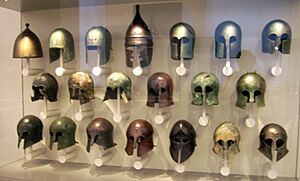
Museum Island continued to grow with more museums. The Neues Museum opened in 1855. Then came the Nationalgalerie (now the Alte Nationalgalerie) in 1876. The Kaiser-Friedrich-Museum (now the Bodemuseum) opened in 1904. Finally, the Pergamonmuseum was completed in 1930. This is how Museum Island became the amazing collection of museums it is today.
Later, between 1894 and 1905, the Berlin Cathedral was rebuilt in a new style. This new cathedral was much larger than Schinkel's original design. It changed the look of the classical group of buildings around the Lustgarten.
What the Museum Showed
A special group of people decided what art would be shown in the new museum. They chose to display only "High Art." This included Old Master paintings and prints and drawings on the upper floor. On the ground floor, they displayed Classical sculpture from ancient Greece and Rome. Other types of artifacts, like those from ancient Near Eastern cultures, were kept in a different place called Schloss Monbijou.
The Museum in the 20th Century
During the time of the Nazis, the Altes Museum was sometimes used as a background for propaganda events. Towards the end of Second World War, the building was badly damaged. A tank truck exploded in front of it, destroying many of the beautiful wall paintings designed by Schinkel and Peter Cornelius.
After the war, the Altes Museum was the first museum on Museum Island to be rebuilt. This work happened from 1951 to 1966. The famous round hall (rotunda) had its murals restored in 1982, following Schinkel's original plans. However, some parts, like the fancy ceilings on the ground floor, were not rebuilt. There were also plans to connect all the museums on Museum Island with an underground passage.
Gallery
-
The vestibule with wall paintings by Peter von Cornelius, 1939.
-
Altes Museum (Berlin) (6340513828).jpg
The Löwenkämpfer (Lion Fighter) statue in front of the museum, 2011.
-
Centaur mosaic - Google Art Project retouched 80Mpixels.jpeg
A mosaic showing a Centaur.
The Antiquities Collection

When the Altes Museum first opened, it held all of Berlin's fine art collections. This included old paintings, prints, and drawings. But since 1904, the museum has focused only on the Antikensammlung, which is a collection of classical antiquities. Since 1998, the ground floor of the Altes Museum has displayed its amazing Greek collection, including many valuable treasures. Special exhibitions are often shown on the second floor.
See also
 In Spanish: Altes Museum para niños
In Spanish: Altes Museum para niños
- List of art museums
- List of museums in Berlin
- List of museums in Germany
- Granite bowl in Lustgarten
- Apulian picture vases for a funeral ceremony (Berlin Antique Collection)


